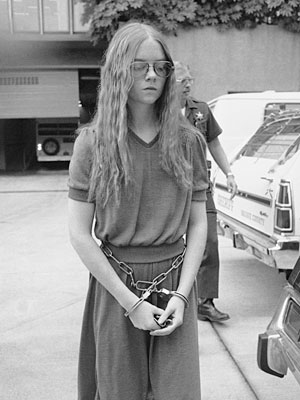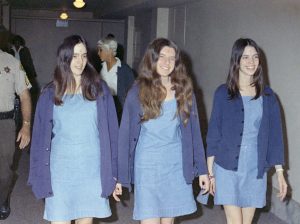“Ugh, it’s Monday” are the words that usually follow the arrival of the most dreaded day of the week. The sighs floating in the air are palpable and nothing seems possible. Mondays always carry with them a negative connotation and contain components such as depression, fatigue, and anguish. But to a San Diego elementary school, and to a troubled sixteen year old, Monday, January 29, 1979 held an even more distressing meaning.

Students at Grover Cleveland Elementary School, located in San Diego, California, began what they believed would be a normal Monday morning like any other, with bells ringing and students racing to their classes. Little did they know, however, that across the street, sixteen-year-old Brenda Ann Spencer was aiming her .22 caliber semiautomatic rifle right at society’s ultimate refuge, the elementary school, and its surroundings. After the first bell rang, Brenda broke the panels on the front door of her home, which was located right across the street from the elementary school. And she began to fire. The school’s principal, Burton Wragg, while rushing outside, was hit on the shoulder and chest with Spencer’s bullets and eventually died. Michael Suchar, the school’s custodian, ran outside with a blanket in order to cover Wragg and keep him from going into shock, but he quickly became the second victim of Spencer’s shooting and lost his life. In between all the chaos, 28 year old Robert Robb, a recent graduate of the police academy, while examining Wragg’s and Suchar’s bodies, was shot under his right shoulder blade.1 He would go on to survive though, along with the eight other children who were wounded in the incident. At least three of those children had abdominal wounds. A nine-year-old student, Cam Miller, was struck in the back with a bullet that exited through his chest without hitting any internal organs. Another, Christy Buell, was shot through her abdomen and in the buttocks, and had to undergo surgery in order to repair her intestine.2
When Gus Stevens, a reporter for the San Diego Evening Tribune, began calling around the area to gain more information about the shooting, he coincidentally placed a call to Spencer’s home where she gave him exactly what he wanted. She described the shooter, a sixteen year old, and the shooter’s address. When Stevens realized that she gave him her own address, he recognized what was going on and requested an interview while another staff member informed the police of the situation. The police, now aware of where the shots were coming from, were able evacuate the children and obstruct Spencer’s line of sight while trying to negotiate with her. After several hours, Brenda Spencer surrendered her weapon and several rounds of ammunition, and was subsequently arrested. While on the phone with Stevens, Spencer had stated that she was just shooting for the “fun of it.” She went on to say that she just didn’t like Mondays and did this “because it’s a way to cheer up the day.”3

Contrary to her initial claim, she later went on to state in her 2001 parole hearing that she had been “sexually abused by [her] father” and was “waiting for the cops to show up so they could shoot [her].”4 This new information has fueled many more theories today about Brenda Spencer’s true motives in committing such a crime. During her pretrial psychological testing, an injury to Spencer’s temporal lobe came to light. Spencer has also stated in a letter from prison that she experiences “grand mal seizures” that she has to counteract with medications.5 Such a brain injury would definitely be a precursor to epilepsy, which is two to four times more common among violent offenders than the public.6 The lack of treatment she received for this disease, to some, proves the neglect that she experienced from her family and in her childhood. Psychologist Jonathan Fast introduces the idea that her brain injury, abuse, and the effects of it pushed her to her final actions. He believes that the shame, ridicule, inferiority, and powerlessness that she felt encouraged her to go as far as she did. In another letter she wrote in prison, she stated that her “father had done everything a person could do to another person. The beatings, the touching, the emotional abuse.” She went on to state that no one, not teachers or counselors, gave her assistance through this, so she simply thought that this was how the world and how life worked. When her father gifted her the .22 caliber rifle, she thought that he was finally telling her to do it: to take her life successfully, unlike her past suicide attempts, and leave the world forever.7
Whether these theories are true or not, Brenda Spencer was tried as an adult and pleaded guilty to two counts of murder and nine counts of assault. She was sentenced to twenty-five years to life in prison, and is still serving her sentence at the California Institute for Women. The shooting has inspired a song by the Boomtown Rats called “I Don’t Like Mondays,” and has also gained other media coverage through a documentary.8 Her action went down in history as the first high profile school shooting and has become a vanguard to many future, unimaginable school situations and violent outbreaks. Whether Spencer was a cold-hearted killer or a truly lost and confused soul that simply wanted an escape, it is undeniable that her horrible actions have had some frightening consequences in our modern world.
- Jonathan Fast, Ceremonial Violence (New York: The Overlook Press, 2008), 25, 70-71. ↵
- Tamara Jones, “Look Back in Sorrow,” Good Housekeeping 227, no.5 (November 1998): 118. ↵
- Jonathan Fast, “Unforgiven and Alone: Brenda Spencer and Secret Shame,” in School Shootings: International Research, Case Studies, And Concepts For Prevention, ed. Nils Böckler (New York: Springer, 2013), 253-255. ↵
- Debra Sevey, “Subsequent Parole Consideration Hearing of Brenda Spencer,” (Capitol Electronic Reporting, 2001), 15-16. ↵
- Jennifer Furio, Letters From Prison: Voices Of Women Murderers (New York: Algora Pub., 2001), 134. ↵
- Jonathan Fast, ” Unforgiven and Alone: Brenda Spencer and Secret Shame,” in School Shootings: International Research, Case Studies, And Concepts For Prevention, ed. Nils Böckler (New York: Springer, 2013), 251. ↵
- Jennifer Furio, Letters From Prison: Voices Of Women Murderers (New York: Algora Pub., 2001), 134-135. ↵
- Encyclopedia of School Crime and Violence, September 2011, s.v. “Brenda Spencer,” by Laura L. Finley. ↵



243 comments
Martina Rodriguez
Great article! I was surprised that out of seemingly no where J P Morgan appears on the naval scene. Although, I have to wonder why White Star Line let themselves be bought out if the company was so important to the country. I don’t know much about international markets, but did they HAVE to sell? I was shocked to read about the undercover illegal activity the Navy had planned unbeknownst to all the passengers. I wonder if there was any investigation into why the ship somehow was moving of her own power…is that normal? Overall, a very well written article and more than enjoyable to read!
Engelbert Madrid
I can’t believe the reason that Brenda Spencer committed such a horrible crime in a elementary school was that she hated Mondays. She probably said that just to say something when she was asked on why she did this. It would have been very heartbreaking that children were killed in this shooting. But still, I feel puzzled by the actions of Brenda Spencer, because she was young. Unfortunately, Spencer was trapped in her negative emotions because of her past experiences that tormented her life.
Kacey Diaz
Like most articles about school shootings, this one was no exceptions on being such a sad article to read. I think this hit me mostly because of the small children that had to experience this and thinking on the world now and how my little brothers are in elementary school, it really hits home and its sad. The information in this article was really well written with lots of details.
Rylie Kieny
I cannot imagine that such a heinous crime like this happened as a way of coping with pain. Everyone during some point in their life will experience pain, grief and other crippling emotions. However coping with those emotions through violence is never the answer. This article was very well written in that it tells the day from start to finish. It is very interesting how the news casts unintentionally helped police catch Brenda. It is very heartbreaking to hear what her father did to her but that will never justify her actions of that day.
Emily Jensen
The terrifying fact about humanity is that every one of us is capable of making the same choice that Brenda Ann Spencer made back in 1979. Brenda managed to dehumanize an entire school of young children and the faculty, picking them off one by one. I found it interesting that she answered the phone and provided all the information to locate her. A great read!
Jose Sanchez
This article was very descriptive. I was unaware that this was the first high profile school shooting. It is sad to see that these school shooting have only become more and more common in our time. We often find that those who commit these horrible acts have suffered in some way such as Brenda Spencer. We must do more to prevent this and help the people who need help before these acts occur and we ask ourselves where we went wrong.
Pamela Callahan
Whether Brenda Spencer was a sixteen year old with intent to kill or a depressed teen acting on her intense emotions will forever remain unclear. In the case that she was a depressed teen, I would just like to say that I wish no person ever had to go through the pain and suffering that she had been through. I know their pain is intense and that not everyone can relate to them, but I also wish that people would consider their actions more carefully and the consequences that they could have on the people around them.
Stephanie Silvola
I am sure that this could be investigated further now in this age to see if she was really a lost soul or a psychopath. Kids who have been tortured and abused and do horrible acts for attention to me is heartbreaking. I am not condoning her actions but if she was really mental then I can’t help but feel a little sympathy. For the two men who died, I am saddened. For her father, why would he gift her a gun? That is unsafe and careless of him. We will never know if he what he did to her was true, but if it is true then I am disgusted.
Madison Downing
I really didn’t realize, until I read your article, how school shootings were happening even when my parents were children. It’s a terrible thing to notice and I honestly don’t want to believe that it was been happening any longer. When you were explaining how Brenda was shooting her victims it made it sound like target practice, she went after the principle, janitor, cop, children. Whoever was in her line of sight she shot. You did mention how she could be very mentally ill and had to put up with tremendous abusive from her father but how she said she shot all these innocent happy people because she wanted to make the day better… I feel like she should have had more years in prison, especially since she took away the life of two men, one who went out to investigate and the other trying to save the first. What a honestly tragedy that breaks my heart.
Indhira Mata
I can not believe that the first actual school shooting was done in 1996. That is not far from today, and it is scary to see the effects this incident has caused in our society today. Brenda is an example of the origins of someone that plans a school shooting. She was either abused and suffered or just wired differently from the rest. The good thing is that the first school shooting did not have alot of deaths. I can not believe that just like today’s kids everyone thought it was a typical day.